This Article Is Based On The Research 'Nonlinear wave evolution with data-driven breaking' and MIT article 'Engineers use artificial intelligence to capture the complexity of breaking waves'. All Credit For This Research Goes To The Researchers Of This Paper 👏👏👏 Please Don't Forget To Join Our ML Subreddit
When waves reach a certain height, they break, cresting and breaking into a shower of droplets and bubbles. These waves can range in size from a surfer’s point break to a soft ripple coming to shore. For decades, the intricacies of how and when a wave breaks have been too complicated to anticipate.
MIT engineers have developed a new method for simulating how waves break. The researchers tweaked equations previously used to predict wave behavior using machine learning and data from wave-tank tests. Engineers frequently use equations like this to aid in constructing robust offshore platforms and structures. The equations, however, have not been able to reflect the intricacy of breaking waves until recently.
The researchers discovered that the modified model was more accurate in predicting how and when waves would break. The model, for example, predicted a wave’s steepness just before it died, as well as its energy and frequency after it broke, more accurately than traditional wave equations.

Scientists will better comprehend how a breaking wave impacts the water surrounding it thanks to their studies published in the journal Nature Communications. Understanding how these waves interact can aid in the development of offshore constructions. It can also help forecast how the water interacts with the environment. Scientists may use improved predictions of how waves break to anticipate how much carbon dioxide and other atmospheric gases the ocean can absorb.
Associate Professor Themis Sapsis of Mechanical and Ocean Engineering at MIT and an affiliate of the Institute for Data, Systems, and Society, explained that Wave breaking is what gets air into the ocean. Wave breaking may seem insignificant, but it becomes profoundly crucial to climate forecast when one spreads its influence over the entire ocean.
Lead author and MIT postdoc Debbie Eeltink, Aix-Marseille University’s Hubert Branger and Christopher Luneau, Kyoto University’s Amin Chabchoub, University of Geneva’s Jerome Kasparian, and Delft University of Technology’s T.S. van den Bremer are among the study’s co-authors.
Scientists often use one of two ways to forecast the dynamics of a breaking wave: either they try to recreate the wave precisely at the size of individual water and air molecules, or they undertake experiments to describe waves using actual observations. The first is computationally expensive and difficult to model even across a small region, while the second takes a long time to execute enough experiments to provide statistically significant findings.
Instead, the MIT researchers used elements from both methodologies to create a machine-learning-based model that is more efficient and accurate. The researchers began with equations commonly used to describe wave behavior. They wanted to enhance the model by “training” it on data from actual trials of breaking waves.
Eeltink, while referring to trials that included wave breaking, said that they had a simplistic model that didn’t capture wave breaking; after that, they wanted to apply machine learning to figure out how to tell the two apart.
Experiments in a 40-meter-long tank provided the researchers with wave-breaking data. A paddle was attached to one end of the tank, which the team used to start each wave. The paddle was positioned to create a breaking wave in the tank’s center. As waves traveled down the tank, gauges along the length of the tank monitored the water’s height.
Eeltink explained that running these studies takes much time. Before starting the next experiment, one must wait for the water to calm down. Otherwise, the experiments will interfere.
The researchers conducted around 250 trials, using the data to train a neural network, a machine-learning technique. The algorithm is taught to compare the actual waves in trials with the anticipated waves in the basic model and then tweak the model to suit reality depending on any disparities between the two.
After training the system with their experimental data, the researchers fed it completely fresh data — this time, measurements from two separate tests conducted in different wave tanks with various diameters. In these experiments, they discovered that the updated model generated more accurate predictions than the simple, untrained model, such as better estimations of the steepness of a breaking wave.
The new model also represented the “downshift,” A wave’s frequency is changed to a lower value, an essential feature of breaking waves. The frequency of a wave determines its speed. Lower frequencies travel quicker than higher frequencies in ocean waves. As a result, the wave will accelerate following the downshift. The new model forecasts the shift in frequency before and after each breaking wave, which might be helpful in coastal storm preparation.

The team’s modified wave model is available as open-source code, which others may be able to use in climate simulations of the ocean’s ability to absorb carbon dioxide and other atmospheric gases, for example. Simulated testing of offshore platforms and coastal constructions can also use the code.
Sapsis explained that the primary goal of this model is to forecast how a wave will behave. He also added that you might use this to replicate waves to aid in building structures more efficiently and safely, but if you don’t represent wave breaking correctly, it may impact how buildings behave.
Their model’s predictions should aid researchers in improving ocean climate models and refining offshore structure design.
Paper: https://www.nature.com/articles/s41467-022-30025-z.pdf
Source: https://news.mit.edu/2022/wave-model-ai-0429
Credit: Source link


Comments are closed.